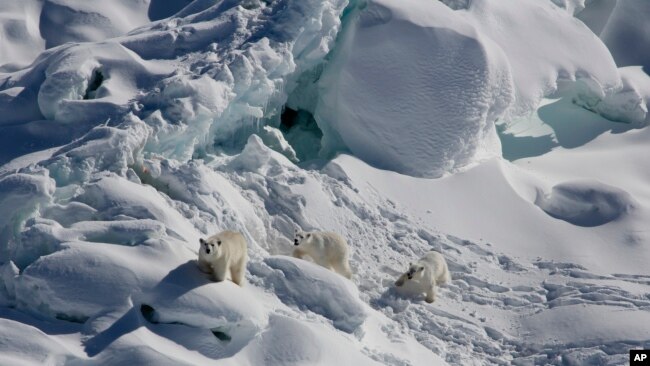グリーンランドのホッキョクグマ、絶滅の危機に!
ホッキョクグマにとって”Oasis ” という単語がこれほど複雑で、深い意味を持っているとは。
夏の暑さも、冬の寒さも耐えます!
肉も控えます!
便利さも快適さも減らします!
私にできることは何でも!!
生態系を守ること、それは地球を守ることなのですから!!!
VOA で英語を学びましょう!!
あらゆることに常に関心を持ちましょう!! それが私たちの努め。
グリーンランドのホッキョクグマは生き残るための場所を発見したのか(和訳)
Polar Bears in Greenland Might Have Found Place to Survive
June 20, 2022
北極圏の海氷が消滅し、ホッキョクグマが生存競争にさらされるなか、グリーンランドの新しいクマたちは、少数の個体群が”生き残る”ため氷の領域を見つけたようです。
しかし、絶滅の危機に瀕しているホッキョクグマの状況は、全体として依然として深刻です。科学者たちは、気候変動の影響により、この動物が絶滅の危機に瀕していると述べています。
グリーンランド南東部に生息する数百頭のホッキョクグマの群れを調査した科学者チームがいます。これらのクマは遺伝的に異なり、地理的にも他のクマとは異なっています。
これらのクマが珍しいのは、アザラシを狩るのに十分な海氷がある日が年間100日しかないのに、生き延びていることです。他の地域では、ホッキョクグマが効果的に狩りをするためには、少なくとも180日、通常はそれ以上の海氷が必要です。海氷がないときは、数ヶ月間食事をとらないこともあるそうです。
海氷は海水が凍ったものです。グリーンランド南東部のホッキョクグマは、この海氷が少ないため、氷山と呼ばれる淡水の氷塊を利用します。グリーンランド氷床が縮小してできた氷山は、狩猟の場として機能している、と科学者は言います。
この新しい発見に関する研究は、最近出版されたScience誌に掲載されました。
しかし、科学者たちは、ホッキョクグマが他の個体群よりも小さく、子供の数が少ないために生き延びている可能性があるかどうかはわからないと言います。
クリスティン・レイドレ氏この研究の主執筆者です。レイドレ氏は9年間にわたり、-通常ヘリコプターからこの真っ白なクマたちを追跡調査し、テストを行いました。
「これらのホッキョクグマは未来のような環境に適応しています。」とレイドレ氏は言います。
しかし、レイドレ氏はグリーンランドが特別であることを付け加えています。「北極のほとんどのクマには氷河の氷がありません 。」と。
レイドレ氏は、「我々は北極圏全体でホッキョクグマの大幅な減少を予測しており、この研究はその非常に重要なメッセージを変えるものではありません。」と説明しています。
ホッキョクグマの生息地は、町のないグリーンランド南東部です。長年、科学者たちはこれらのホッキョクグマがグリーンランド北東部に存在する同じ個体群の一部であると思っていました。
しかし、彼らはそうではありませんでした、とレイドレ氏は言います。64 degrees North 北緯64度付近の風やその他の条件から、クマがその地点より北へ移動することは不可能に近いと彼女は付け加えます。
ほとんどのクマは4日間で40キロメートル移動しますが、南東グリーンランドのクマは同じ時間で10キロメートルほど移動することがこの研究でわかりました。
「彼らは何年も何年も同じ場所に留まっているのです。」とレイドレ氏は話します。
ベス・シャピロ氏は、この研究の共同執筆者です。彼女は、南東グリーンランドのクマが他のホッキョクグマ集団とは異なることを遺伝子検査で明らかにしたと言います。
一般に、南東グリーンランドのクマは他の北極圏のクマよりも痩せており、メスの体重は約185キログラム。これは、北米北極圏の他の地域のクマの体重が約199キログラムから255キログラムであることと比較してのことだと、レイドレ氏は言います。
また、南東グリーンランドのクマは子供を産まないことが多いと言います。これは彼らが孤立しているため、繁殖の機会が少ないからかもしれません。
「彼らは他の個体ほど繁殖していないのです。より良い環境にいる他の個体ほど健康ではありません。」とシャピロ氏は言います。
彼女は、クマが住んでいる場所を表現するのに、オアシス–不快なものに囲まれた安全な場所という意味–という言葉を使っています。
「つまり、オアシスのようなものかもしれませんが、幸せなオアシスではありません。」とシャピロ氏は言います。「それは、なんとか-やっていこうと、もがいている-でも-なんとかやっていこうとしている-そんなオアシスなのです。」
Polar Bears in Greenland Might Have Found Place to Survive
As polar bears fight for survival because of disappearing Arctic sea ice, a new group of Greenland bears seems to have found an icy area that might permit a small population to “hang on.”
But the situation overall for the endangered polar bear species remains serious. Scientists say the animals are in danger of disappearing because of the effects of climate change.
A team of scientists recently studied a group of a few hundred polar bears in Southeast Greenland. These bears are genetically different and geographically separate from others.
What is unusual about these bears is that they survive even while having just 100 days a year when there is enough sea ice to hunt seals. In other places, polar bears need at least 180 days, usually more, of sea ice for them to effectively hunt. When there is no sea ice, bears often do not eat for months.
Sea ice is frozen ocean water. With limited amounts of this ice, the Southeast Greenland polar bears use freshwater ice masses called icebergs. The icebergs – created from the shrinking Greenland ice sheet – serve as hunting grounds, scientists say.
A study on the new finding recently appeared in the publication Science.
The scientists, however, are not sure if the bears might be surviving because they are smaller and have fewer babies than other polar bear populations.
Kristin Laidre was the lead writer of the study. Over nine years, Laidre followed, studied and tested the all-white bears - usually from a helicopter.
“These polar bears are adapted to living in an environment that looks like the future,” Laidre said.
But Laidre added that Greenland is special. “Most bears in the Arctic don’t have glacial ice,” she said.
Laidre explained, “We project large declines of polar bears across the Arctic and this study does not change that very important message.”
The population of polar bears is on the southeast part of Greenland, where there are no towns. For years scientists believed these bears were part of the same population that existed in Northeast Greenland.
But they are not, Laidre said. Wind and other conditions around 64 degrees North make it next to impossible for bears to move north of that point, she added.
While most bears travel 40 kilometers over four days, the Southeast Greenland bears go about 10 kilometers in the same amount of time, the study found.
“They just stay in the same place for years and years,” Laidre said.
Beth Shapiro was the co-writer of the study. She said genetic testing has shown that the Southeast Greenland bears are different from other polar bear populations.
In general, the Southeast Greenland bears are thinner than other Arctic bears, with females weighing about 185 kilograms. This compares to weights of about 199 to 255 kilograms for bears in other parts of the North American Arctic, Laidre said.
The Southeast Greenland bears also often have fewer babies, she added. This could be because they are so isolated and do not get as many chances to reproduce.
“They’re not reproducing as much as other individuals... They’re not as healthy as other individuals who are in a better habitat,” Shapiro said.
She used the term oasis – meaning a safe place that is surrounded by something unpleasant - to describe where the bears live.
“So it’s kind of an oasis maybe, but it’s not a happy oasis,” Shapiro said. “It’s a I’m-struggling-to-get-by-but-just-making-it kind of oasis.”
Words in This Story
hang on – phr v. to barely keep surviving
ice sheet – n. a permanent layer of ice covering a large area of land, especially a polar region
species – n. biology : a group of animals or plants that are similar and can produce young animals or plants : a group of related animals or plants that is smaller than a genus
adapt – v. to change (something) so that it functions better or is better suited for a purpose
isolate – v. to put of keep someone or something in a place or situation that is separate from others
habitat – n. the place or type of place where a plant or animal naturally or normally lives or grows
